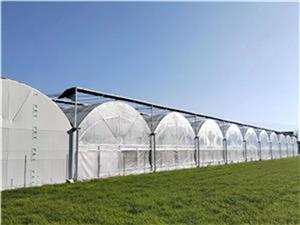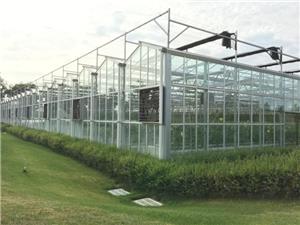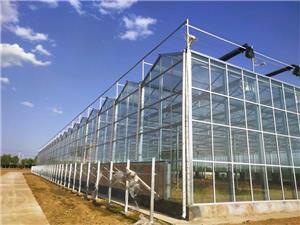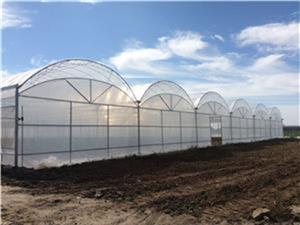Greenhouse dehumidification methods
A glass greenhouse is a greenhouse mainly covered with glass as the transparent material. It has a long service life and is suitable for different regions and climates. It is divided into many different types of greenhouses, each used for growing different plants. Here are eight methods for dehumidification in glass greenhouses.
1. Ventilation
Ventilation is a simple and feasible concept for dehumidification in glass greenhouses. However, in tropical regions, it is also necessary to strengthen ventilation to avoid a drop in indoor temperature. If the temperature drops too quickly during ventilation, promptly close the ventilation opening to prevent a sudden drop in temperature and put the crops in danger.
2. Appropriate irrigation
The main factor causing an increase in indoor humidity is water. During the production in winter and spring, the yield can be irrigated separately on sunny days, and plastic films covered with mulch can be used for irrigation under the film. During irrigation, the water volume should be strictly controlled to prevent excessive indoor humidity. After each irrigation, wind irrigation should be used, and the soil should be loosened with a hoe in real time, which can simultaneously reduce soil humidity and air humidity.
3. Film coating
Using film coverage can reduce the evaporation of soil moisture, which is an important measure to lower the air humidity in glass greenhouses. The concept of large and thin ridges in glass greenhouses and double ridges, where water flows into the small ridges under the plastic film, can be useful during irrigation. The plastic film hinders water evaporation and prevents a significant increase in air humidity in the greenhouse after a flood.
4. Heating and cooling
This step can meet the temperature requirements of the crops and reduce the relative humidity of the air. When the plants reach the resistance point, the temperature of the dense greenhouse irrigation can be raised to around 30°C, and ventilation for 1 hour should be carried out, then ventilation for dehumidification should be carried out. After 3-4 hours, when the humidity is lower than 25°C, it can be repeated once.
5. Using heat-insulating curtain materials with excellent moisture absorption properties
Materials with good moisture permeability and moisture absorption properties can prevent internal condensation, reduce air humidity, and prevent a significant increase in air humidity in the greenhouse after a flood.
6. Natural moisture absorption
Materials such as straw, wheat straw, and lime can be used to absorb water vapor or fog in the row space to achieve the purpose of dehumidification.
7. Cultivation and dehumidification
After cutting off the soil capillary tubes, prevent the capillary tubes from entering the water surface to prevent excessive evaporation of soil moisture.
8. Increasing light transmittance
Increasing light transmittance can raise the room temperature. After the room temperature rises, ventilation should be carried out frequently to achieve the purpose of dehumidification.
A glass greenhouse is a greenhouse mainly covered with glass as the transparent material. It has a long service life and is suitable for different regions and climates. It is divided into many different types of greenhouses, each used for growing different plants. Here are eight methods for dehumidification in glass greenhouses.
1. Ventilation
Ventilation is a simple and feasible concept for dehumidification in glass greenhouses. However, in tropical regions, it is also necessary to strengthen ventilation to avoid a drop in indoor temperature. If the temperature drops too quickly during ventilation, promptly close the ventilation opening to prevent a sudden drop in temperature and put the crops in danger.
2. Appropriate irrigation
The main factor causing an increase in indoor humidity is water. During the production in winter and spring, the yield can be irrigated separately on sunny days, and plastic films covered with mulch can be used for irrigation under the film. During irrigation, the water volume should be strictly controlled to prevent excessive indoor humidity. After each irrigation, wind irrigation should be used, and the soil should be loosened with a hoe in real time, which can simultaneously reduce soil humidity and air humidity.
3. Film coating
Using film coverage can reduce the evaporation of soil moisture, which is an important measure to lower the air humidity in glass greenhouses. The concept of large and thin ridges in glass greenhouses and double ridges, where water flows into the small ridges under the plastic film, can be useful during irrigation. The plastic film hinders water evaporation and prevents a significant increase in air humidity in the greenhouse after a flood.
4. Heating and cooling
This step can meet the temperature requirements of the crops and reduce the relative humidity of the air. When the plants reach the resistance point, the temperature of the dense greenhouse irrigation can be raised to around 30°C, and ventilation for 1 hour should be carried out, then ventilation for dehumidification should be carried out. After 3-4 hours, when the humidity is lower than 25°C, it can be repeated once.
5. Using heat-insulating curtain materials with excellent moisture absorption properties
Materials with good moisture permeability and moisture absorption properties can prevent internal condensation, reduce air humidity, and prevent a significant increase in air humidity in the greenhouse after a flood.
6. Natural moisture absorption
Materials such as straw, wheat straw, and lime can be used to absorb water vapor or fog in the row space to achieve the purpose of dehumidification.
7. Cultivation and dehumidification
After cutting off the soil capillary tubes, prevent the capillary tubes from entering the water surface to prevent excessive evaporation of soil moisture.
8. Increasing light transmittance
Increasing light transmittance can raise the room temperature. After the room temperature rises, ventilation should be carried out frequently to achieve the purpose of dehumidification.




